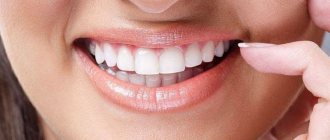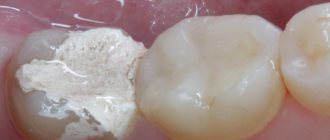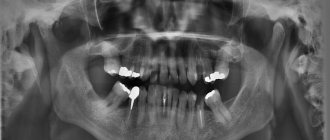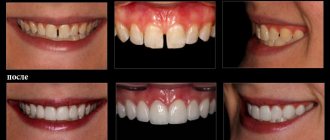| Turnkey teeth whitening 19900 rub. 35000 rub. + 15% for restoration of anterior teeth after whitening This promotion is valid only until 09/30/2020 |
The offer includes: - Professional teeth cleaning: Air-Flow, ultrasonic cleaning, fluoridation) - In-office teeth whitening ZOOM4 Philips
| Cost of composite restoration (composite veneer) from 9500 rub. |
Indications and contraindications for composite dental restoration
It is used both for the treatment of caries and only for restoring the aesthetics of the tooth. Artistic reconstruction is mainly carried out in the front row, since defects affect the beauty of the smile.
The procedure is carried out in the following cases:
- the presence of cracks and chips in the enamel;
- caries, large, visible fillings;
- non-carious lesions: enamel erosion, fluorosis;
- differences in shape and size of adjacent teeth;
- fracture, destruction of the crown, if a healthy root is preserved;
- dark spots that cannot be bleached with drugs;
- slight curvature, tilt;
- interdental spaces (trema, diastema);
- erasing the cutting edge.
The procedure is not performed in cases of severe inflammation of the gums or tissues in the root area, bruxism (night grinding of teeth), allergies to composite materials, significant destruction of dental tissues, or absence of adjacent units. Reconstruction will have to be postponed during pregnancy, since many local anesthetics are contraindicated, especially in the first and last trimester.
In what cases is restoration of lateral teeth with composites suitable?
Restoration with filling material is carried out in cases of destruction of up to 50% of the tooth surface
- Fissure surface destruction
- Volumetric failed fillings
- Carious cavities
- Chips of mounds, walls
In case of significant destruction of hard tissues, it will be necessary to additionally install a pin for strengthening. When more than half of the tissue is lost, restoration is not always possible. In this case, alternative methods are indicated - inlays or crowns.
Types of composites
For direct restorations performed directly in the mouth, high-quality materials from Europe and the USA are used. Dental clinics in Moscow often use the very durable Filtek nanocomposite, the most aesthetically pleasing Venus, and a material with a large palette of Enamel Plus shades.
For indirect reconstruction, other composite materials are used. Veneers and inlays are created from an impression in the laboratory. Finished products are baked in an oven rather than hardened by exposure to light. In this case, the composite is used less often than ceramics or metal-ceramics.
Restoration of chewing teeth in our Center
We comply with the principles of modern dentistry; specialists act in accordance with the Center’s Unified Quality Standards
- Using a microscope All work on the treatment and restoration of the shape of teeth is carried out using a Seiler dental microscope under multiple magnification. We carefully trim the affected tissues while preserving the maximum possible amount of healthy ones.
- Latest generation materials We use original, advanced premium materials with minimal risk of chipping. The degree of elasticity and thermal expansion are close to those of tooth tissue. They have the required density and are able to hold their shape.
The use of a rubber dam is mandatory in our Center and is included in the cost of the service. Allows you to qualitatively isolate the area from excess moisture and foreign contaminants. This guarantees that bacteria will not enter the cavity and secondary caries will not develop, and the material will adhere tightly to the tooth tissues.
Advantages and disadvantages
For aesthetic restoration of teeth, different materials are used: photocomposites, ceramics, metal-ceramics and others. You can hide defects under a crown or onlays. Each material and method has its pros and cons.
Advantages of composite restoration:
- the aesthetics and integrity of the dental unit are restored in just one visit to the doctor, there is no need to make impressions and wait several weeks for the manufacture of microprostheses;
- minimal tissue preparation without depulpation;
- the possibility of performing the procedure without anesthesia, which is important for patients with allergies to anesthetics;
- the method is available for the reconstruction of primary teeth in children for whom crowns or veneers are not recommended because the bite is disturbed;
- good aesthetics, strength, wear resistance;
- large selection of shades;
- the material is plastic, easy to model, and working with it is not limited in time;
- there is no rehabilitation period;
- possibility of repair if chipped;
- cheaper than installing ceramic or metal-ceramic veneers.
After 2 - 3 years, the restoration fades and loses its former attractiveness. Composites are quite porous, so they absorb food coloring. However, if you follow the rules of hygiene and exclude foods with food dyes or pigments from your diet, the results will last longer.
The service life of a photopolymer restoration is several times shorter than that of veneers, crowns made of non-matella ceramics or metal ceramics, which is also a significant disadvantage.
What materials are used
The method of filling with a light-curing composite is the most popular in the field of treatment and microprosthetics. The material is called composite resins; it has been used in dentistry for more than fifty years, but the composition of the mixture is constantly being refined for better strength and aesthetics. Hybrid composites are now in use. The main requirement for the material is adhesiveness. The filling must fit tightly to living tissues and take an anatomical shape.
Composites differ in their composition, which determines their viscosity. The material is selected according to the type of work and the characteristics of the jaw. This includes the restoration of chewing teeth and incisors, as well as the polishing of teeth, since they perform different functions. However, there are universal mixtures. Any composite consists of:
- organic matrix (base responsible for strength, flexibility, etc.);
- inorganic filler (occupies 50% of the composition);
- silane, which connects the other two components.
High-quality material for teeth extensions has the following qualities:
- wear resistance;
- resistance to mechanical stress;
- visibility on x-ray;
- persistent color;
- the degree of shrinkage during hardening is within normal limits;
- thermal expansion;
- compatibility with client tissues;
- aesthetic characteristics.
Also, the composite should be easy to use. The modern composition is nanocomposite. This substance shines, hardly shrinks, is well polished, does not lose color, and is durable. However, it is not yet available everywhere and is unlikely to be affordable for the average patient.
Progress of the procedure
There is no need to prepare in advance for artistic restoration using photo composites. If the direct technique is used, the reconstruction is completed in just 1 to 2 hours.
Stages:
- professional cleaning of plaque and stone, selection of composite according to enamel color;
- local anesthesia - carried out in case of preparation of dental tissues;
- drilling affected tissues (for caries), old fillings or grinding enamel for better adhesion;
- isolation from saliva, since moisture is unacceptable when applying composite materials;
- surface etching;
- layer-by-layer application of light-curing material of different shades and transparency gradients to imitate natural enamel;
- drying each layer with an ultraviolet lamp;
- grinding (grinding off excess) to form an ideal shape and fit the bite;
- polishing for smoothness.
If the coronal part is severely damaged, then a pin is installed, which supports the structure and makes it more stable. The pins are made from titanium or fiberglass, as regular metal rods can show through and impair aesthetics. However, a better restoration in this case involves the installation of inlays or crowns.
With the indirect method, the veneer or inlay is installed in two stages. The first stage involves preparing the tooth and taking impressions. The restoration components are manufactured in a dental laboratory. At the second stage, the overlays are fixed with cement paste.
Advantages of the method
The optimal way to quickly, inexpensively and efficiently restore one or more teeth in one visit to the clinic
- Result in 1 visit If a chip or crack suddenly appears, you can completely restore the defect in one visit
- grinding Healthy tissues are practically not affected, only the minimum necessary layer is removed
- Possibility of correction If necessary, the doctor can correct the shape; composites can be corrected and replaced
- Affordable price The cheapest way to restore a defect with full restoration of natural functions
Restoration of a group of chewing teeth is possible under comfortable sedation
Restoration of one tooth takes about an hour. If restoration of several teeth is required, the procedure can be performed in a state of medicated sleep. It is possible to restore up to 8 teeth in one visit . Safe drugs cause a state of half-asleep, the patient relaxes, does not experience discomfort and fatigue. 30-40 minutes after waking up, you can go home in a clear mind.
Levin Dmitry Valerievich Chief physician and founder of the Doctor Levin center
How long does the restoration last and how to increase its service life?
If you maintain oral hygiene, a composite veneer will last approximately 4 years, possibly more. The average term is 5 years.
In order to increase the restoration period, you need to follow simple rules:
- brush your teeth to remove plaque twice a day;
- do not use abrasive toothpastes or hard toothbrushes;
- rinse your mouth after eating;
- Avoid foods that are too hard (can be crushed) and foods with food coloring.
If you do not follow the rules, for example, abuse coffee, black tea, or smoke, then the restored tooth will darken and lose its shine within a year. The material can also chip if the tooth is subjected to excessive stress, for example, with the habit of chewing a pencil or cracking nut shells.
Advantages and disadvantages of the procedure
The prevalence of composite restoration is associated with the many benefits of the procedure. These include:
- Successful restoration of functionality. A damaged tooth regains all its lost functions - it is strong and has the necessary shape to chew food and bite without pain or discomfort. And since the dental unit has its own root, after the restoration is completed there is no sensation of a foreign object in the oral cavity.
- Aesthetics. As a result of the procedure, the appearance of the smile improves, since the restored tooth is completely indistinguishable from its “neighbors” and has the correct shape.
- Fast recovery. In most cases, the procedure requires only one trip to the dental clinic.
- Price. The service is very inexpensive, which allows everyone to restore the beauty of their smile.
The disadvantages of composite restoration include only a shorter service life compared to prosthetics. This is due to the possibility of damage to the restored tooth due to improper care. After the procedure, the dentist gives clear recommendations for caring for the renewed teeth.
Alternative options
If you are not satisfied with the aesthetic performance and fragility of composites, then you can consider other restoration options:
- Ceramic, zirconium or metal-ceramic veneers. Unlike composite ones, they are installed only indirectly. Ceramic overlays are more aesthetically pleasing and are indistinguishable from natural enamel in shade and transparency. Some microprostheses can last 10 - 15 years or more. However, the price of one veneer starts from 25,000 rubles, and ultra-thin plates can cost 2–3 times more.
- Ceramic or metal inlays. A more reliable alternative to composite on a pin, but also more expensive. Most often used on chewing teeth.
- Crowns. Indicated for use if the outer part of the tooth is severely damaged. They are made from different materials: zirconium dioxide, metal-free ceramics, metal ceramics. Durable, wear-resistant, last for many years.
Stages of restoration
- Hygienic cleaning Professional hygiene, cleaning the surface of teeth to remove plaque and deposits.
- Selection of material High-strength materials are used, density is taken into account, and shade is selected.
- Installation of rubber dam To ensure insulation - prevents the entry of saliva and moisture for the best adhesion.
- Surface preparation Removal of caries and old fillings if necessary, preparation, application of degreasing composition and adhesive.
- Application of material Restoration of the physiological shape of the tooth by layer-by-layer application of composites with ultraviolet illumination.
- Correction and polishing Shaping contours, polishing with tools with varying degrees of abrasiveness to avoid rapid accumulation of plaque.
conclusions
The purpose of this article was to present the indications for minimally invasive treatment in addition to conservative orthodontic, prosthetic and implant treatment and to suggest possible treatment options. It should be noted that new treatments may fail when they exceed the indications for the use of specific materials and techniques. The described cases show that modern conservative dentistry has a wide range of indications and it is possible to treat a wider range of cases. Adhesive composite fiberglass bar bridges are an additional option for replacing a single missing tooth. They can also be used as high-quality, long-term provisional restorations before implantation.
Modern composites meet the expectations of the doctor and the patient. A combination of direct and indirect techniques for the restoration of anterior teeth has good prospects. It simplifies complex treatment, for example helping to create correct occlusion, and creates more effective and less cost-effective dentistry.











